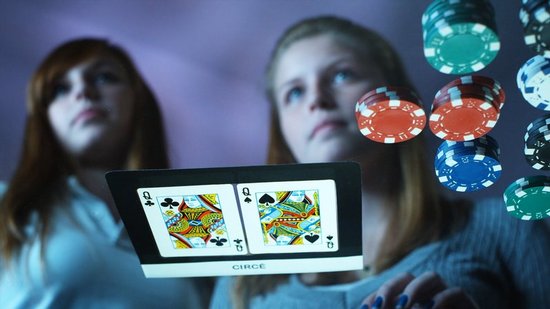
© » KADIST
Adriana Martínez
Her work Al final del arcoiris (At the end of the rainbow, 2015) is a bundle of bills from Chile, Venezuela, Brazil, Colombia, Nicaragua, and Costa Rica, arranged by color to form a tight spiraling rainbow held close with a rubber band. Here, Martinez uses these various currencies to gesture towards questions of capital and value, the accumulation of wealth, and regional economies. Beneath the surface of her playful visual propositions, Martinez asks us to consider not only the monetary costs of international goods, but also the real, human consequences of a global economic culture that privileges some and devastates others.

© » KADIST
Adriana Martínez
Her 2015 work Orión is a black flag-like cloth with glow-in-the-dark symbols embroidered in the shape of the constellation. In the place of stars, Martínez has substituted the logos of international corporations and entities that use stars as their symbol; celestial navigation commanded by the logic of international corporations. Easily spotted is the smiling face of the Carl’s Jr. / Hardee’s logo, the three-pronged Mercedes-Benz emblem, Walmart’s six-pointed asterisk, and the starry cluster of the Subaru shield.
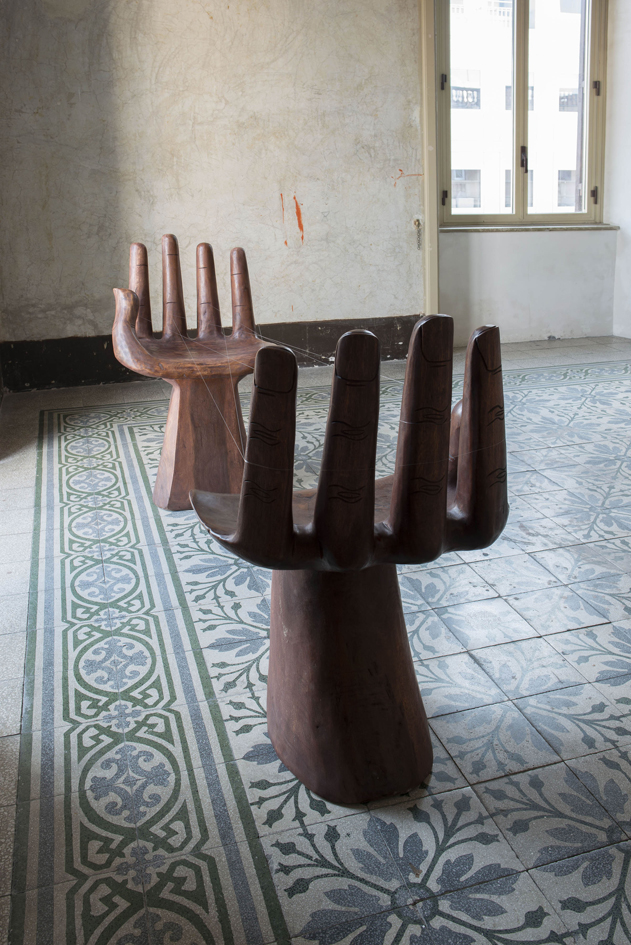
© » KADIST
Adriana Lara
Lara uses things readily at hand to create objects and situations that interrogate the processes of art and the spectrum of roles that art and artists play in society. To these ends, she has used furniture, projections, photographs, clothing, and even people as her materials. A reflection on how the production of meaning itself takes place in the manufacturing of things is embodied in wooden hand chairs, a crafty Indonesian version of the iconic Pedro Friedeberg 1960s Pop design.

© » KADIST
Adriana Bustos
El mar y sus múltiples afluentes (The Sea and its Multiple Tributaries) builds on the concept of trafficking that Adriana Bustos has been exploring over the last decade. The piece represents an apocryphal river and illustrates the routes of the slave trade between the coasts of Africa, Europe, and South America, departing from the Congo River (once called Zaira), and arriving at Río de la Plata, the main river in Buenos Aires that divides Argentina from Uruguay. The work collapses time and space, placing the coasts of colonial empires across the colonies where slaves were taken.
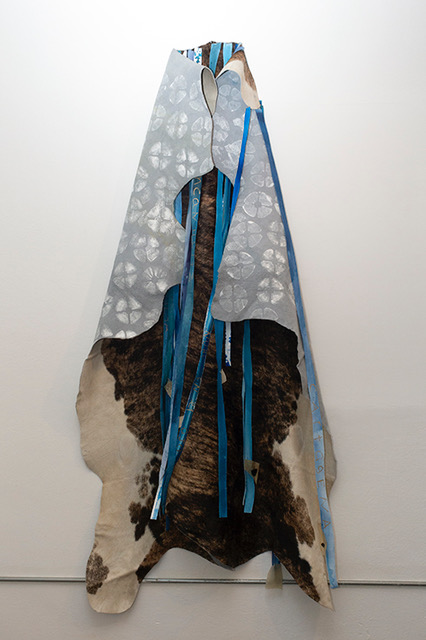
© » KADIST
Noé Martínez
As he investigates the forms that slavery took through different events that occurred during the sixteenth century in the Huasteca region of Mexico, Noé Martínez tells, in a non-linear narrative, the history of human trafficking in Relación de tráfico de personas 1525-1533 I (Study of Trafficking of Persons 1525–1533 I) . Both the departure of Huasteco Indians from the Americas, and the arrival of Africans from Cape Verde, Angola, Congo and Mozambique unravel in Martinez work as a story that has remained sealed in the colonial archives, and that continues under different guises in contemporary times. Relación de tráfico de personas 1525-1533 I is part of a series made of interventions in tanned leathers that refer to the exchange of human beings for pack animals and cattle in the Caribbean Sea.

© » KADIST
Adrían Balseca
Adrian Balseca’s Suspensión I inverts the logic of the old colonial game, the greasy pole. Digitally filmed in the Province of Morona Santiago among the last existing community at the entrance of the Sangay National Park, a native girl climbs a balsa tree trunk from which plastic containers filled with “local” fossil fuels hang (super, extra, eco-país, gasoline, diesel, etc.). The trunk – which is lightweight quality wood, typical of the subtropical jungle of Ecuador -– has been cut down and suspended vertically and the trophies of modern progress hang from it.

© » KADIST
Adrían Balseca
The project Grabador Fantasma (Phantom Recorder) consists of a communally constructed technological device in Sarayaku ancestral territory. Adrian Balseca’s site-specific composition is an “ecología del paisaje sonoro”, an artifact that collects sounds produced by different organisms, amplifying the complex historical plot of the area. From a traditional Sarayaku Peracian Dacryodes Copal wood barge with a solar cell panel system, an electric motor, a gramophone, and a recording system wireless audio, the specific characteristics of the soundscape are registered and transformed.

© » KADIST
Adrian Wong
Untitled (Grate I/II: Shan Mei Playground/ Grand Fortune Mansion) is part of a series drawn from architectural objects that mark the boundary of public and private spaces Wong encountered while strolling in Hong Kong. Intrigued by the accidental preservation of historical building material by renovations and rebuilding, Wong began paying attention to the experience conveyed by layered forms accreted to affect the visual historicity of a space. The geometric forms in the piece are welded together as a composite replica of a metal grate from a children’s playground next to Wong’s studio, a security grate door from his apartment complex, and the latticework that holds an air conditioner from an electronic store, and a front grate from an elementary school on his bus route.

© » KADIST
Martine Syms
Her 2016 video installation quotes the sitcom-as-form and also draws from a 1907 comedic short, Laughing Gas. Syms’s 4-channel installation follows the central character (an aspiring artist also named Martine Syms) on a journey home from the dentist after receiving “laughing gas.” Mixing multiple points of view, clips borrowed from TV, as well as layers of comedy, fiction, reality, and critique, Syms’ work also delves into issues of race, culture, and representation. For Los Angeles-based Martine Syms, popular culture, television, and the cultural histories woven through both are starting points for her interdisciplinary art practice.

© » KADIST
Adriano Costa
Westminster Agua Viva is made from Westminster City Council(‘s) recycling bin bags, glued together, that the artist has painted and cut or cut and painted. Although, they hang on the wall they possess a strong sculptural quality as the fringes float away from the wall. This is part of a series of works that refer to Brazilian concrete and neo-concrete art as well as Arte Povera in a playful manner while demonstrating a strong identity of its own.

© » KADIST
Claudia Martínez Garay
escenario chacana by Claudia Martínez Garay is a sculptural work composed of a frame-like structure that contains a series of ceramic pieces. It references the Chakana, an Andean cross that encompasses the different levels of existence (known as Pachas) and sacred elements contained in the Indigenous cosmologies of the region. It often appears in the geometrical motifs of textiles and ceramics.

© » KADIST
Daniel Joseph Martinez
Martinez’s sculpture A meditation on the possibility… of romantic love or where you goin’ with that gun in your hand , Bobby Seale and Huey Newton discuss the relationship between expressionism and social reality in Hitler’s painting depicts the legendary Black Panther leaders Huey P. Newton and Bobby Seale. By using Carrara marble, a material usually associated with heroic public sculptures, Martinez casts the history of African-American revolutionaries into the artistic tradition of monumentality. Like the artist’s earlier work included in the 1993 Whitney Biennial, an interactive piece made up with pins that read, “I CAN’T IMAGINE EVER WANTING TO BE WHITE,” A meditation on the possibility… continues Martinez’s effort to expose cultural contradictions and increase public awareness.
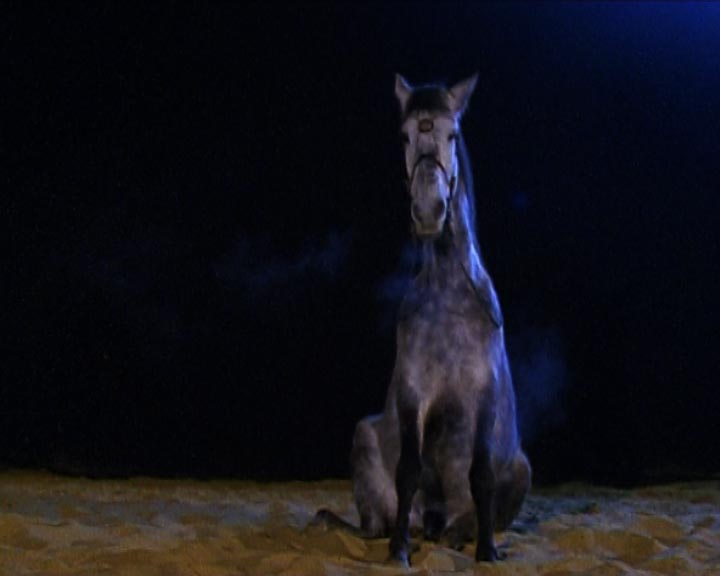
© » KADIST
Carolina Saquel Martinez
The artist films a horse dressage session at night, in a dimly lit manège. In this video the artist recalls the importance of traditional equestrian portraits in Spanish painting and relates to the repetitive passage between the rider and the mount. This effect of repetition is accentuated by the video played in a loop and the fixed framing of the image shot from the ground, with body posture and dressage themes as a method for training and obedience.

© » KADIST
Daniel Joseph Martinez
For I use to eat lemon meringue pie till I overloaded on my pancreas with sugar and passed out; It seemed to be a natural response to a society of abundance (1978), also known as the Bodybuilder series, Martinez asked male bodybuilding competitors to pose in whatever position felt “most natural.” They are obviously trained in presenting their ambitiously carved physiques, but their facial expressions seem comparatively unstudied. Against a bare white background, the men appear unexpectedly vulnerable, caught between performance and rehearsal, public and private. While they present themselves deliberately as exemplars of strength, they also inadvertently expose something about the value system that underlies their endeavors—whatever drove them to keep building by tearing tissue, and whatever makes flexing feel like the most honest pose possible.

© » KADIST
Daniel Joseph Martinez
Drawing & Print (Drawing & Print)
If Only God Had Invented Coca Cola Sooner! Or, The Death of My Pet Monkey

© » KADIST
Adrian Villar Rojas
The two drawings in the Kadist Collection are part of a larger series entitled Las Mariposas Eternas (The Eternal Butterflies). They are studies for two large sculptures that explore the role of monuments and emblems in the configuration of Latin American national identities. The first drawing reproduces an equestrian statue of Juan Lavalle, one of Argentina’s independence heroes.

© » KADIST
Adrian Villar Rojas
Drawing & Print (Drawing & Print)
Based on historical prophecies and fantasy, the artist creates apocalyptic scenarios that posit an enigmatic world plagued by social, political, and environmental upheaval. Untitled (Set of Six Drawings) (2012) is an intricate watercolor of a child sitting cross-legged with its head stuck inside a giant mask resembling a duck head covered with eyes. It looks like a scene snatched from science fiction or a surreal dream; it is tempting to see in it some kind of warning sign, or an ominous vision of the future.

© » KADIST
Adrian Melis Sosa
Shot a few months before the USA and Cuba restored diplomatic relations in 2015, The New Man and My Father looks into the quiet aftermath of one family’s individual experience of the Cuban Revolution (1953-1959). The film brings to the fore a socio-political system made for a country whose successes and failures fell upon the individual men and women who experienced it. In the film, Melis interviews his father about the Cuban Revolution, as well as the more recent re-introduction of capitalism to the island after 60 years of the US-imposed embargo.
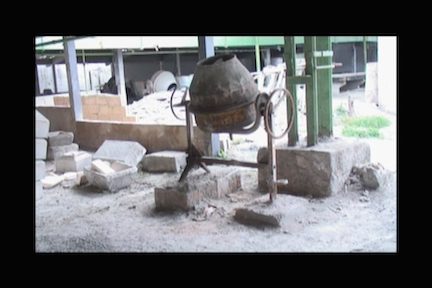
© » KADIST
Adrian Melis Sosa
In Cuba, due to the lack of materials, workers of state-owned construction companies must remain at work without doing anything, waiting for the end of the working day. Interested in this phenomenon, Adrian Melis asked the workers of a construction company to reproduce the sounds and noises characteristic of their work. The making of forty rectangular pieces for a floor construction is the recording of a “work performance” during a day from eight in the morning to five in the afternoon.

© » KADIST
Martin Creed
This photograph of Martin Creed himself was used as the invitation card for a fundraising auction of works on paper at Christie’s South Kensington in support of Camden Arts Centre’s first year in a refurbished building in 2005. His broad smile, on the verge of laughter, encourages reciprocity on behalf of the onlooker. This could be said to be a typical tactic in Creed’s work as it is so infused with humor and irony.
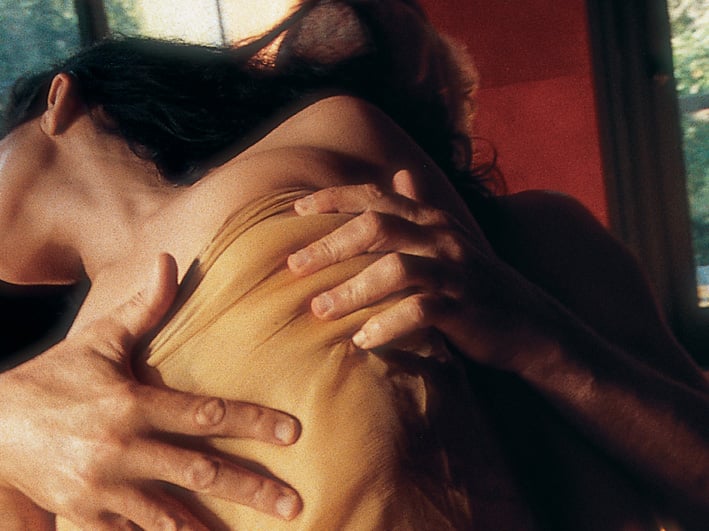
© » KADIST
Daria Martin
In keeping with her mythological proclivity, Minotaur (2009) casts a new light on an old narrative. The film takes the ancient Greek story of the half-man, half-bull as its title subject, but at its core, Minotaur is an homage to pioneering modern dancer and choreographer, Anna Halprin. Along with Trisha Brown, Simone Forti, and Yvonne Rainer, Halprin’s fearless and lifelong dance practice paved the way for the evolution of modern and contemporary dance as we understand it today.

© » KADIST
Adrien Missika
Adrien Missika follows in the footsteps of the Brazilian landscape architect and artist Roberto Burle Marx (1909-1994), a designer of gardens, parks and promenades who introduced modern landscape architecture to Brazil. Marx’s work is characterized by the use of native tropical vegetation as a structural element of design. He worked with Oscar Niemeyer and Lucio Costa, the architects of Brazilia, and with them, the tropical plant became a motif in urban architecture.

© » KADIST
Daria Martin
Soft Materials is a curious, touching but also disturbing sequence of confrontations between two people: a man and a woman, and machines. Shot in the Artificial Intelligence Laboratory at the University of Zurich, the humans and the machines mirror each other’s actions. It is unclear which party takes the lead.

© » KADIST
Martin Kippenberger
Drawing & Print (Drawing & Print)
7″ Single ‘Pop In’ by Martin Kippenbergher consisting of a vinyl record and a unique artwork drawn by the artist on the record’s sleeve. In the foreground of the album’s cover, a drawing of an empty, round vessel is framed underneath the text “POP IN”, suggesting an invitation to listen to the record, a nod to pop music, or perhaps a literal proposal to enter the vessel or the work. In the background, partly hidden by the round form, Kippenberger’s hand-drawn self portrait glares back at the viewer.

© » KADIST
Martin Boyce
In the installation Our Love is like the Flowers, the Rain, the Sea and the Hours, Martin Boyce uses common elements from public gardens – trees, benches, trashbins– in a game which describes at once a social space and an abstract dream space. The trees, unique sources of light in the exhibition space, produce their own environment. These sculptures, as if extracted from a set, are enough to suggest an atmosphere, a landscape, or a movie.
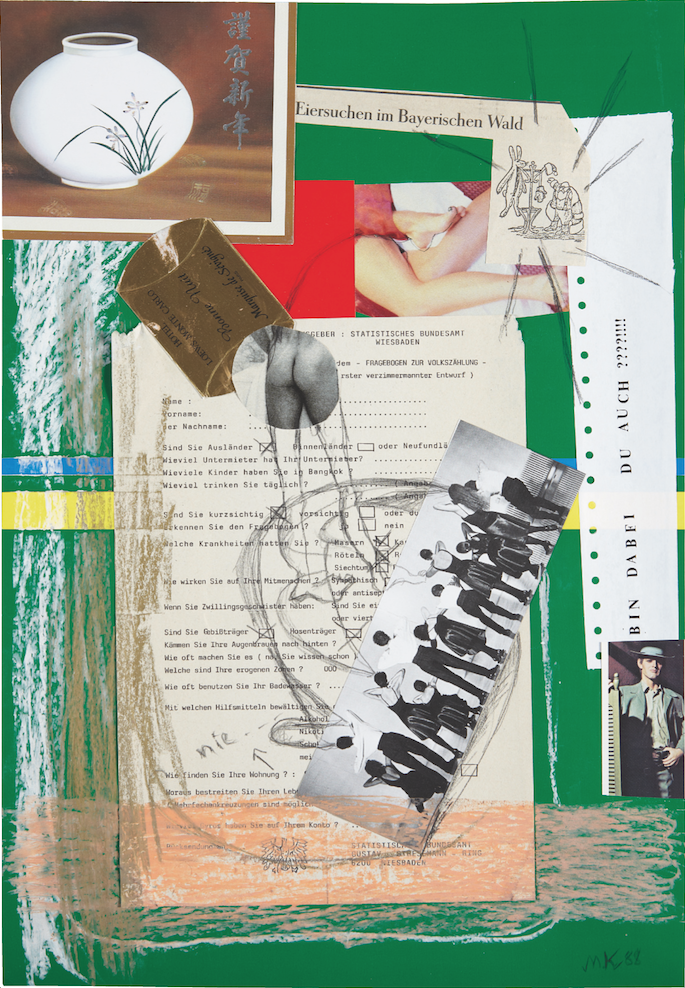
© » KADIST
Martin Kippenberger
Martin Kippenberger’s late collages are known for incorporating a wide range of materials, from polaroids and magazine clips to hotel stationery, decals, and graphite drawings. Untitled is a collage on paper work by Kippenberger that typifies his everything-goes approach: a barely discernible, sliced image of Michael Jackson’s face is overlaid and woven with strips and triangular shapes from a different source into a single composition. Blue tones come from torn out pages of a book where fragments of illustrations can be seen.

© » KADIST
Martin Kippenberger
Drawing & Print (Drawing & Print)
Untitled is a work on paper by Martin Kippenberger comprised of several seemingly disparate elements: cut-out images of a group of dancers, a japanese ceramic vase, and a pair of legs, are all combined with gestural, hand-drawn traces and additional elements such as a candy wrapper from a hotel in Monte Carlo and a statistical form from a federal government office in Wiesbaden, Germany. Text cut out from a Newspaper spells out in German “Egg hunting in the Bavarian forest” and an additional piece of text reads in all capitals “BIN DABEI DU AUCH” (“I’m here too” in English). Together, all the messages and geographies from the separate elements suggest an alternative, highly stylized portrait of the artist; in this case, a fragmented, fluid, and itinerant sense of identity.

© » KADIST
Diana Thater
In Perpetual Motion (2005) the seemingly erratic flight of the bright orange Monarch butterfly—filmed in its winter habitat of Michoacán, Mexico—is intensified by the artist’s editing in which frames are randomly dropped and the film is sped up. As a result, the butterflies become hyper-real and animated in appearance. The manipulated footage is presented in a video wall of nine monitors, where the butterflies flit from screen to screen, in a room bathed in vivid orange light.

© » KADIST
Mariana Castillo Deball
Mariana Castillo Deball’s set of kill hole plates are part of a larger body of work problematizing archeological narratives, and drawing attention to the conservation process and its role in recreating an imagined object. They are playful and exaggerated representations of “kill hole pottery” — ceramic dishes in the Mimbres tradition with distinct circular holes located in the center of the pots. Although very little is known about the Mimbres culture’s specific beliefs, they are loosely understood to have terminated the object symbolically in preparation for funerary use.
Mariana Castillo Deball
- location: Amsterdam & Berlin
- year born: 1975
- gender: female
- nationality: Mexican
- home town: Mexico City, Mexico
Martin Kippenberger
- location: Vienna, Austria
- year born: 1953
- gender: male
- nationality: German
- home town: Dortmund, Germany
Martin Creed
- location: Wakefield, United Kingdom
- year born: 1968
- gender: male
- nationality: British
Daniel Joseph Martinez
- location: Los Angeles, California
- year born: 1957
- gender: male
- nationality: American
- home town: Los Angeles, California
Adrian Villar Rojas
- year born: 1980
- gender: male
- nationality: Argentinean
Daria Martin
A number of Daria Martin’s films explore the relationship between humans and machines and make reference to modernist art, whether through the work of the Bauhuas (Schlemmer), Surrealism (Giacometti’s Palace at 4 AM) or American art of the 1960s and 1970s...
Adrian Melis Sosa
Adrian Melis’s work is committed to presenting the range of intensity and nuance of human energy embodied through acts of resistance, resilience, and productivity...
Olive Martin and Patrick Bernier
Patrick Bernier and Olive Martin are a duo of artists collaborating since 1999...
Martin Boyce
- location: Hamilton, United Kingdom
- year born: 1967
- gender: male
- nationality: British
Adriana Bustos
Adriana Bustos creates a narrative discourse through installation, video, photography and drawing, in which her reflections on prevailing social, political or religious oppression appear in non-linear interpretations of history...
Michael Craig-Martin
Michael Craig-Martin studied fine art at Yale University returning to Europe in the mid-1960s and becoming one of the key figures in the first generation of British conceptual artists...
Adriano Costa
Adriano Costa is a Brazilian artist (born in1975) living in Sao Paolo....
Carolina Saquel Martinez
Caroline Saquel was born in Chile and now lives and works in Paris...
Martine Syms
- location: Los Angeles, California
- year born: 1988
- gender: female
- nationality: American
- home town: Los Angeles, California
Adrian Wong
- location: Hong Kong, China
- year born: 1980
- gender: male
- nationality: American
- home town: Chicago, Illinois
Adriana Lara
Adriana Lara is fascinated by how a single thing (an object, a photograph, a song, a text) can be transformed into a work of art...
Diana Thater
A pioneer of video and film installations for over a decade, Diana Thater’s works explore the nature and possibilities of moving-image media...
Adrien Missika
Adrien Missika (1981, Paris, France) studied and developed his career in Lausanne where he founded 1m3 artspace...
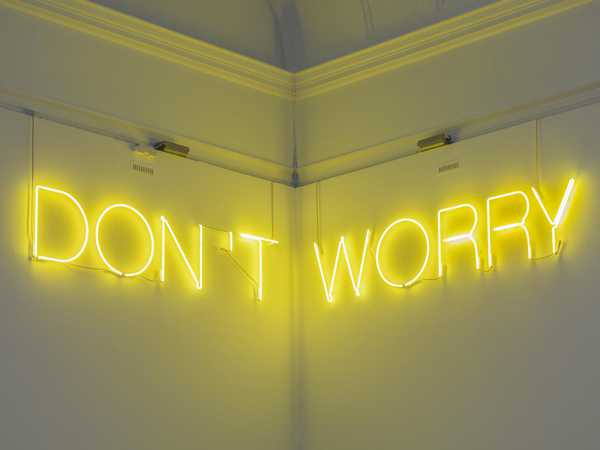
© » TATE EXHIBITIONS
about 3 months ago (01/06/2024)
Martin Creed | The Dick Institute Experience the work of one of this country’s most ingenious, audacious and surprising artists at the Dick Institute ARTIST ROOMS Martin Creed presents highlights from the British artist’s thirty-year career...
-
1970-1979
Daniel Joseph Martinez
1978For I use to eat lemon meringue pie till I overloaded on my pancreas with sugar and passed out; It seemed to be a natural response to a society of abundance (1978), also known as the Bodybuilder series, Martinez asked male bodybuilding competitors to pose in whatever position felt “most natural.” They are obviously trained in presenting their ambitiously carved physiques, but their facial expressions seem comparatively unstudied...
-
1980-1989
Martin Kippenberger
1988Martin Kippenberger’s late collages are known for incorporating a wide range of materials, from polaroids and magazine clips to hotel stationery, decals, and graphite drawings...
Martin Kippenberger
Drawing & Print
1989(Drawing & Print) 7″ Single ‘Pop In’ by Martin Kippenbergher consisting of a vinyl record and a unique artwork drawn by the artist on the record’s sleeve...
Martin Kippenberger
Drawing & Print
1989(Drawing & Print) Untitled is a work on paper by Martin Kippenberger comprised of several seemingly disparate elements: cut-out images of a group of dancers, a japanese ceramic vase, and a pair of legs, are all combined with gestural, hand-drawn traces and additional elements such as a candy wrapper from a hotel in Monte Carlo and a statistical form from a federal government office in Wiesbaden, Germany...
-
2000-2009
Martin Creed
2003This photograph of Martin Creed himself was used as the invitation card for a fundraising auction of works on paper at Christie’s South Kensington in support of Camden Arts Centre’s first year in a refurbished building in 2005...
Martin Boyce
2003In the installation Our Love is like the Flowers, the Rain, the Sea and the Hours, Martin Boyce uses common elements from public gardens – trees, benches, trashbins– in a game which describes at once a social space and an abstract dream space...
Daria Martin
2004Soft Materials is a curious, touching but also disturbing sequence of confrontations between two people: a man and a woman, and machines...
Daniel Joseph Martinez
2005Martinez’s sculpture A meditation on the possibility… of romantic love or where you goin’ with that gun in your hand , Bobby Seale and Huey Newton discuss the relationship between expressionism and social reality in Hitler’s painting depicts the legendary Black Panther leaders Huey P...
Diana Thater
2005In Perpetual Motion (2005) the seemingly erratic flight of the bright orange Monarch butterfly—filmed in its winter habitat of Michoacán, Mexico—is intensified by the artist’s editing in which frames are randomly dropped and the film is sped up...
Diana Fonseca Quiñones
2007In Los amantes (The lovers) Diana Fonseca Quiñones uses simple, commonplace objects and experiences that she derives from daily life to develop narratives that mix reality and fiction...
Adrian Melis Sosa
2008In Cuba, due to the lack of materials, workers of state-owned construction companies must remain at work without doing anything, waiting for the end of the working day...
Daria Martin
2008In keeping with her mythological proclivity, Minotaur (2009) casts a new light on an old narrative...
Mariana Castillo Deball
2009Do ut des (2009) is part of an ongoing series of books that Castillo Deball has altered with perforations, starting from the front page and working inward, forming symmetrical patterns when each spread is opened...
-
2010-2019
Adrian Villar Rojas
2010The two drawings in the Kadist Collection are part of a larger series entitled Las Mariposas Eternas (The Eternal Butterflies)...
Olive Martin and Patrick Bernier
2010The Mohawk, the emblematic Frontier river in the period of American colonisation, is here a cable of data transmission, and the 7 Sultans Casino is a virtual destination, one of the three hundred online casinos hosted by the servers located in Kahnawake, a small native american indian reserve to the south of Montreal...
Adrian Wong
2012Untitled (Grate I/II: Shan Mei Playground/ Grand Fortune Mansion) is part of a series drawn from architectural objects that mark the boundary of public and private spaces Wong encountered while strolling in Hong Kong...
Adrian Villar Rojas
Drawing & Print
2012(Drawing & Print) Based on historical prophecies and fantasy, the artist creates apocalyptic scenarios that posit an enigmatic world plagued by social, political, and environmental upheaval...
Adrien Missika
2013Adrien Missika follows in the footsteps of the Brazilian landscape architect and artist Roberto Burle Marx (1909-1994), a designer of gardens, parks and promenades who introduced modern landscape architecture to Brazil...
Adriana Lara
2014Lara uses things readily at hand to create objects and situations that interrogate the processes of art and the spectrum of roles that art and artists play in society...
Adriano Costa
2014Westminster Agua Viva is made from Westminster City Council(‘s) recycling bin bags, glued together, that the artist has painted and cut or cut and painted...
Adriana Martínez
2015Her work Al final del arcoiris (At the end of the rainbow, 2015) is a bundle of bills from Chile, Venezuela, Brazil, Colombia, Nicaragua, and Costa Rica, arranged by color to form a tight spiraling rainbow held close with a rubber band...
Adriana Martínez
2015Her 2015 work Orión is a black flag-like cloth with glow-in-the-dark symbols embroidered in the shape of the constellation...
Adrian Melis Sosa
2015Shot a few months before the USA and Cuba restored diplomatic relations in 2015, The New Man and My Father looks into the quiet aftermath of one family’s individual experience of the Cuban Revolution (1953-1959)...
Mariana Castillo Deball
2015Taking archaeology as her departure point to examine the trajectories of replicated and displaced objects, “Who will measure the space, who will tell me the time?” was produced in Oaxaca for her exhibition of the same title at the Contemporary Museum of Oaxaca (MACO) in 2015...
Martine Syms
2016Her 2016 video installation quotes the sitcom-as-form and also draws from a 1907 comedic short, Laughing Gas...
Adriana Bustos
2018El mar y sus múltiples afluentes (The Sea and its Multiple Tributaries) builds on the concept of trafficking that Adriana Bustos has been exploring over the last decade...
Adrían Balseca
2018The project Grabador Fantasma (Phantom Recorder) consists of a communally constructed technological device in Sarayaku ancestral territory...
Noé Martínez
2019As he investigates the forms that slavery took through different events that occurred during the sixteenth century in the Huasteca region of Mexico, Noé Martínez tells, in a non-linear narrative, the history of human trafficking in Relación de tráfico de personas 1525-1533 I (Study of Trafficking of Persons 1525–1533 I) ...
Adrían Balseca
2019Adrian Balseca’s Suspensión I inverts the logic of the old colonial game, the greasy pole...
Claudia Martínez Garay
2019escenario chacana by Claudia Martínez Garay is a sculptural work composed of a frame-like structure that contains a series of ceramic pieces...


